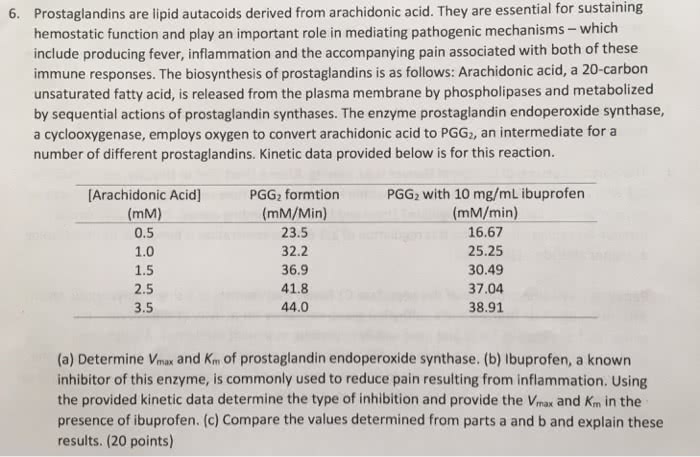1 / 2 Q1. Prostaglandins are a class of eicosanoids, fatty acid derivatives with a variety of extremely potent actions on vertebrate tissues. They are responsible for producing fever and inflammation and its associated pain. Prostaglandins are derived from the 20-carbon fatty acid arachidonic acid in a reaction catalyzed by the enzyme prostaglandin endoperoxide synthase. This enzyme, a cyclooxygenase, uses oxygen to convert arachidonic acid to PGG2, the immediate precursor of many different prostaglandins. A). The kinetic data given below are for the reaction catalyzed by prostaglandin endoperoxide synthase. Focusing here on the first two columns, determine the Vmax and Km of the enzyme. [Arachidonic acid] Rate of formation of PGG2 ) Rate of formation of PGG2 with (10 mg/mL ibuprofen) (mM) (mM min−1) (mM min−1 0.5 23.5 16.67 1.0 32.2 25.25 1.5 36.9 30.49 2.5 41.8 37.04 3.5 44.0 38.91 B) Ibuprofen is an inhibitor of prostaglandin endoperoxide synthase. By inhibiting the synthesis of prostaglandins, ibuprofen reduces inflammation and pain. Using the data in the first and third columns of the table, determine the type of inhibition that ibuprofen exerts on prostaglandin endoperoxide synthase. a) What is the Vmax in the absence and presence of inhibitor? b) What is the Km in the absence and presence of inhibitor? c) What kind of inhibitor is it likely to be?
1 / 2 Q1. Prostaglandins are a class of eicosanoids, fatty acid derivatives with a variety of extremely potent actions on vertebrate tissues. They are responsible for producing fever and inflammation and its associated pain. Prostaglandins are derived from the 20-carbon fatty acid arachidonic acid in a reaction catalyzed by the enzyme prostaglandin endoperoxide synthase. This enzyme, a cyclooxygenase, uses oxygen to convert arachidonic acid to PGG2, the immediate precursor of many different prostaglandins. A). The kinetic data given below are for the reaction catalyzed by prostaglandin endoperoxide synthase. Focusing here on the first two columns, determine the Vmax and Km of the enzyme. [Arachidonic acid] Rate of formation of PGG2 ) Rate of formation of PGG2 with (10 mg/mL ibuprofen) (mM) (mM min−1) (mM min−1 0.5 23.5 16.67 1.0 32.2 25.25 1.5 36.9 30.49 2.5 41.8 37.04 3.5 44.0 38.91 B) Ibuprofen is an inhibitor of prostaglandin endoperoxide synthase. By inhibiting the synthesis of prostaglandins, ibuprofen reduces inflammation and pain. Using the data in the first and third columns of the table, determine the type of inhibition that ibuprofen exerts on prostaglandin endoperoxide synthase. a) What is the Vmax in the absence and presence of inhibitor? b) What is the Km in the absence and presence of inhibitor? c) What kind of inhibitor is it likely to be?

